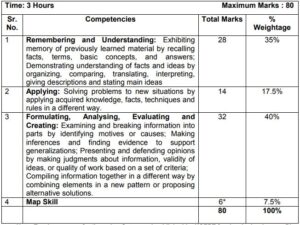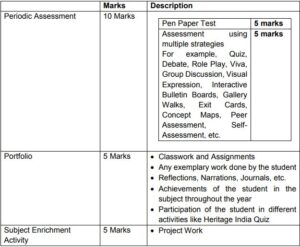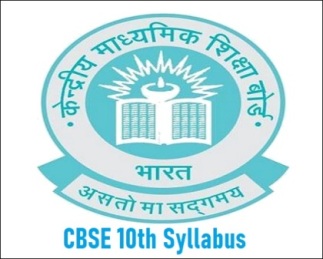CBSE 10th Class Social Science 2022- 2023 complete details have been provided here in this article below. Social Science is one of the important subjects in the Arts stream. Those who have social science as one of the subjects in the 10th standard must be aware of the complete syllabus and examination pattern. Information about the syllabus and examination scheme is also helpful in preparation for the exam. Therefore, we recommend students, make preparation strategies according to the prescribed syllabus and examination scheme. Any changes regarding the syllabus will be updated accordingly. Check crucial information about CBSE Class 10th Social Science Syllabus 2022-23 below.
CBSE Class 10 Social Science Syllabus 2022-23: Course Structure
The students need to collect crucial information about the 10th class social science syllabus for preparing for the board exams. Here is the complete information about CBSE 10th Class Social Science Syllabus 2022-23:
Course Structure: Class 10th Social Science (2022-23)
Theory Paper
Time Duration: 3 Hours
Maximum Marks: 80 Marks
| Units |
Periods Count |
Marks |
| India and the Contemporary World-II |
60 |
20 |
| Contemporary India-II |
55 |
20 |
| Democratic Politics- II |
50 |
20 |
| Understanding Economic Development |
50 |
20 |
| Total |
215 |
80 |
Course Content
| Unit 1: India and the Contemporary World-II |
60 Periods |
| Themes |
Learning Objectives |
| Section 1: Events and Processes
1. The Rise of Nationalism in Europe
- The Age of Revolutions: 1830-1848
- Visualizing the Nation
- The Making of Nationalism in Europe
- The French Revolution and the Idea of the Nation
- The Making of Germany and Italy
- Nationalism and Imperialism
2. Nationalism in India
- The First World War, Khilafat and Non-Cooperation
- Differing Strands within the Movement
- Towards Civil Disobedience
- The Sense of Collective Belonging
Section 2: Livelihoods, Economies, and Societies: Any one of the following theme:
3. The Making of a Global World
- The Pre-modern world
- The Nineteenth Century (1815-1914)
- The Inter war Economy
- Rebuilding a World Economy: The Post-War Era
4. The Age of Industrialization
- Before the Industrial Revolution
- Industrialization in the colonies
- The Peculiarities of Industrial Growth
- Factories Come Up
- Hand Labour and Steam Power
- Market for Goods
Section 3: Everyday Life, Culture and Politics
5. Print Culture and the Modern World
- The First Printed Books
- The Print Revolution and its Impact
- Print Comes to Europe
- The Reading Mania
- India and the World of Print
- The Nineteenth Century
- New Forms of Publication
- Religious Reform and Public Debates
- Print and Censorship
|
- Enable the learners to identify and comprehend the forms in which nationalism developed along with the formation of nation states in Europe in the post-1830 period.
- Understand the way the idea of nationalism emerged and led to the formation of nation states in Europe and elsewhere.
- Establish the relationship and bring out the difference between European nationalism and anticolonial nationalisms.
- Analyze the nature of the diverse social movements of the time.
- Recognize the characteristics of Indian nationalism through a case study of Non-Cooperation and Civil Disobedience Movement.
- Appreciate the ideas promoting Pan Indian belongingness.
- Familiarize with the writings and ideals of different political groups and individuals.
- Discuss how globalization is experienced differently by different social groups.
- Show that globalization has a long history and point to the shifts within the process.
- Analyze the implication of globalization for local economies.
- Familiarize with the process of industrialization and its impact on labour class.
- Familiarize with the Pro- to-Industrial phase and Early–factory system.
- Enable them to understand industrialization in the colonies with reference to Textile industries
- Recognize the link between print culture and the circulation of ideas.
- Familiarize with pictures, cartoons, extracts from propaganda literature and newspaper debates on important events and issues in the past.
- Understand that forms of writing have a specific history, and that they reflect historical changes within society and shape the forces of change.
|
| Unit 2: Contemporary India –II |
55 Periods |
| Themes |
Learning Objectives |
1. Resources and Development
- Types of Resources
- Resource Planning in India
- Development of Resources
- Land Utilization
- Land Resources
- Land Degradation and Conservation Measures
- Land Use Pattern in India
- Classification of Soils
- Soil as a Resource
- Soil Erosion and Soil Conservation
2. Forest and Wildlife
- Conservation of forest and wildlife in India
- Types and distribution of forests and wildlife resources
- Flora and Fauna in India
- Biodiversity or Biological Diversity
- Vanishing Forests
- The Himalayan Yew in trouble
- Asiatic Cheetah: Where did they go?
- Project Tiger
- Community and Conservation
Note: The chapter ‘Forest and Wildlife’ will be assessed in the Periodic Tests only and will not be considered in Board Examination.
3. Water Resources
- Multi-Purpose River Projects and Integrated Water Resources Management
- Water Scarcity and The Need for Water Conservation and Management
- Rainwater Harvesting
Note: The theoretical aspect of chapter ‘Water Resources’ will be assessed in the Periodic Tests only and will not be considered in Board Examination. However, the map items of this chapter as given in the Map List will be evaluated in Board Examination.
4. Agriculture
- Types of farming
- Major Crops
- Cropping Pattern
- Impact of Globalization on Agriculture
- Technological and Institutional Reforms
5. Minerals and Energy Resources
- What is a mineral?
- Mode of occurrence of Minerals
- Non-Metallic Minerals
- Rock Minerals
- Ferrons and Non-Ferrons Minerals
- Conservation of Minerals
- Energy Resources
- Conventional and Non-Conventional
- Conservation of Energy Resources
6. Manufacturing Industries
- Contribution of Industry to National Economy
- Importance of manufacturing
- Classification of Industries
- Industrial Location
- Spatial distribution
- Control of Environmental Degradation
- Industrial pollution and environmental degradation
7. Life Lines of National Economy
- Transport – Roadways, Railways, Pipelines, Waterways, Airways
- Communication
- Tourism as a Trade
- International Trade
|
- Understand the value of resources and the need for their judicious utilization and conservation.
- Analyze the significance of conservation of forests and wildlife
- Recognize the value of biodiversity with regard to flora and fauna in India.
- Realize the importance of water as a resource as well as develop consciousness towards its judicious use and preservation.
- Explain the significance of agriculture in national economy.
- Explain various government policies for institutional as well as technological reforms since independence.
- Identify different types of farming and discuss the various farming methods; explain the spatial distribution of major crops as well as understand the relationship between rainfall regimes and cropping pattern.
- Identify various types of minerals and energy resources and places of their availability
- Realize the need for their judicious utilization
- Talk about the need for a planned industrial development and discuss over the role of government towards sustainable development.
- Bring out the significance of industries in the national economy as well as recognize the regional disparities which resulted due to concentration of industries in some areas.
- Describe the importance of transport and communication in the ever-shrinking world.
- Realize the role of trade and tourism in the economic development of a country
|
| Unit 3: Democratic Politics –II |
50 Periods |
| Themes |
Learning Objectives |
1. Power Sharing
- Forms of Power Sharing
- Why power sharing is desirable?
- Case Studies of Belgium and Sri Lanka
2. Federalism
- What is Federalism?
- How is Federalism practiced?
- What makes India a Federal Country?
- Decentralization in India
3. Democracy and Diversity
- Case Studies of Mexico
- Politics of social divisions
- Differences, similarities and divisions
Note: The chapter ‘Democracy and Diversity’ will be evaluated in the Periodic Tests only and will not be considered in Board Examination.
4. Gender, Religion and Caste
- Religion, Communalism and Politics
- Gender and Politics
- Caste and Politics
5. Popular Struggles and Movements
- Popular Struggles in Bolivia and Nepal
- Mobilization and Organization
- Pressure Groups and Movements
Note: The chapter ‘Popular Struggles and Movements’ to be evaluated in the Periodic Tests only and will not be examined in Board Examination.
6. Political Parties
- Why do we need Political Parties?
- How can Parties be reformed?
- State Parties
- National Political Parties
- How many Parties should we have?
- Challenges to Political Parties
7. Outcomes of Democracy
- How do we assess democracy’s outcomes?
- Accountable, approachable and legitimate government
- Dignity and freedom of the citizens
- Economic growth and development
- Accommodation of social diversity
- Reduction of inequality and poverty
8. Challenges to Democracy
- Thinking about Political Reforms
- Thinking about challenges
- Redefining democracy
Note: The chapter ‘Challenges to Democracy’ will be assessed in the Periodic Tests only and will not be considered in Board Examination. |
- Familiarize with the centrality of power-sharing in a democracy.
- Realize the working of spatial and social power-sharing mechanisms.
- Study federal provisions and institutions.
- Describe decentralization in urban and rural areas.
- Analyze the correlation between social cleavages and political struggle with reference to the Indian situation.
- Recognize the enabling and disabling effects of caste and ethnicity in politics
- Identify and study the challenges posed by communalism to Indian democracy.
- Develop a gender perspective on politics.
- Recognize the important role of people’s struggle in the growth of democracy.
- Understand party systems in democracies.
- Introduction to main political parties, their challenges and reforms in the country.
- Assess the functioning of democracies in comparison to alternative forms of governments
- Differentiate between sources of strengths and weaknesses of Indian democracy
- Understand the causes for the continuation of democracy in India.
- Promote an active and participatory citizenship.
- Reflect on the various kinds of measures possible to deepen democracy.
|
| Unit 4: Understanding Economic Development |
50 Periods |
| Themes |
Objectives |
1. Development
- What Development Promises- Different people different goals
- National Development
- Income and other goals
- Income and other criteria
- How to compare different countries or states?
- Sustainability of development
- Public Facilities
2. Sectors of the Indian Economy
- Sectors of Economic Activities
- Comparing the three sectors in India
- Primary, Secondary and Tertiary Sectors
- Division of sectors as organized and unorganized
- Public and Private Sectors
3. Money and Credit
- Modern forms of money
- Money as a medium of exchange
- Loan activities of Banks
- Two different credit situations
- Terms of credit
- Self Help Groups for the Poor
- Formal sector credit in India
4. Globalization and the Indian Economy
- What is globalization?
- The Struggle for a fair Globalisation
- Impact of Globalization on India
- Factors that have enabled Globalisation
- World Trade Organisation
- Foreign Trade and integration of markets
- Production across countries
- Interlinking production across countries
5. Consumer Rights
Note: Chapter 5 ‘Consumer Rights’ to be done as Project Work. |
- Macroeconomics: Familiarize with concepts.
- Understand the rationale for overall human development in our country, which includes the rise of income, health standard and education system.
- Understand the significance of quality of life and sustainable development.
- Discover major employment generating sectors.
- Reason out the government investment in different sectors of the economy.
- Understand money as an economic concept.
- Recognize the role of financial institutions from the point of view of day-to-day life.
- Describe the working of the Global Economic phenomenon.
- Gets familiarized with the consumer’s duties and rights, and legal channels available to protect from being exploited in markets.
|
PRESCRIBED BOOKS:
- Together Towards a Safer India – Part III, a textbook on Disaster Management – Published by CBSE
- Contemporary India II (Geography) – Published by NCERT
- India and the Contemporary World-II (History) – Published by NCERT
- Democratic Politics II (Political Science) – Published by NCERT
- Understanding Economic Development – Published by NCERT
- Learning Outcomes at the Secondary Stage – Published by NCERT
CBSE Class 10 Social Science Syllabus 2022-23: Question Paper Design
Check question paper design including weightage of topics, assigned marks and exam duration, etc. in the table below:

Note: Teachers may refer to ‘Learning Outcomes’ published by the NCERT for developing Lesson Plans, Assessment Framework and Questions.
Internal Assessment: 20 Marks
Check details in respect of Internal Assessment which will be of 20 Marks as under:

Download the CBSE Class 10th Social Science Syllabus 2022
CBSE Class 10th Syllabus 2022
Note: The CBSE has all rights reserved to modify the syllabus of 10th Class Social Science subjects if required. In this regard, we want to assure you that we will update changes if any in this article. Leave a comment in the following comment box if there is any query with respect to CBSE 10th Class Social Science Syllabus 2022-23.



